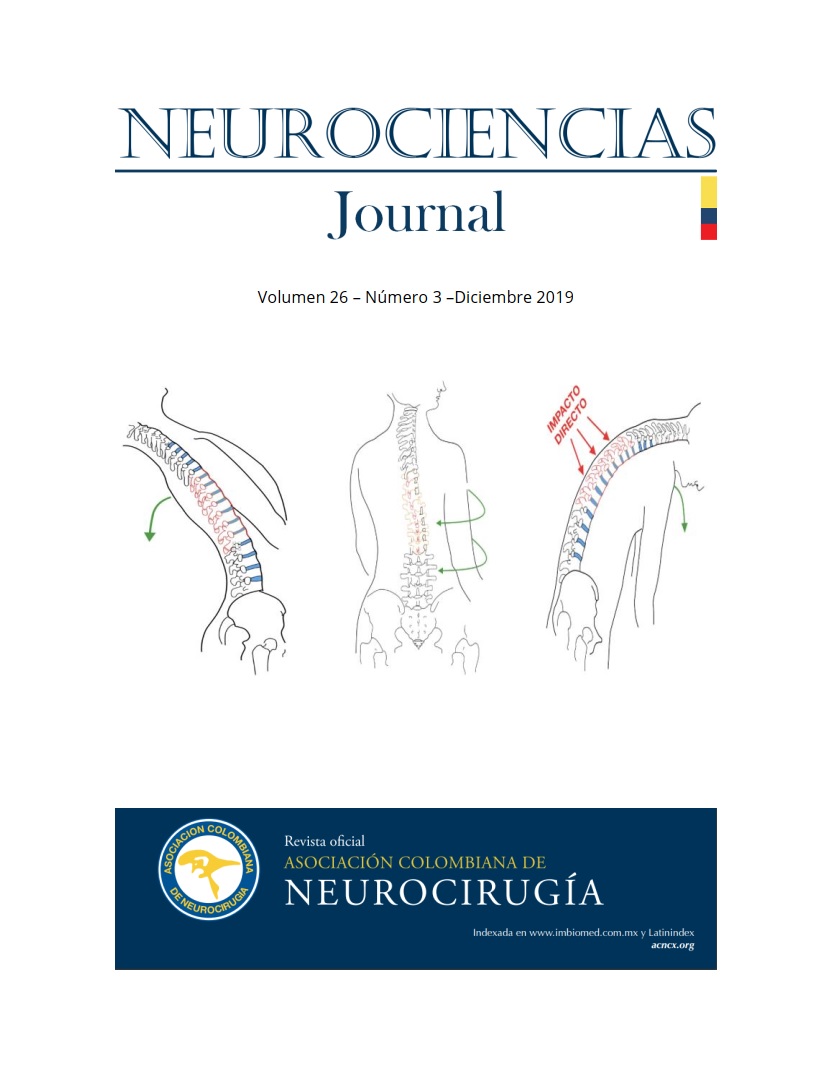HERIDA POR ARMA CORTOPUNZANTE EN COLUMNA TORÁCICA COMO CAUSA DE HEMORRAGIA INTRAVENTRICULAR
DOI:
https://doi.org/10.51437/nj.v26i3.165Palabras clave:
Hemorragia Cerebral Intraventricular, Líquido Cefalorraquídeo, Hidrocefalia, Traumatismos Vertebrales, Heridas Penetrantes.Resumen
La hemorragia intraventricular(HIV) se divide en primaria y secundaria dependiendo de la fuente involucrada en el sangrado; el ventrículo propiamente dicho o cualquier sitio extraventricular respectivamente, siendo la última mucho más frecuente su presentación. tiene origen en una multiplicidad de causas, algunas tan frecuentes como lesiones vasculares e hipertensión arterial y trauma craneoencefálico y otras raras como lesiones infecciosas y PRESS. No se encuentra descripción en la literatura de HIV secundario a herida en columna torácica por arma cortopunzante. La presentación clínica va desde leve compromiso neurológico hasta muerte súbita, siendo la cefalea y deterioro del estado de conciencia los síntomas más sobresalientes. La hipótesis de cómo llega el sangrado a los ventrículos desde una herida por arma cortopunzante en la columna torácica nos remite a la discusión de la dinámica del flujo del Líquido Cefalorraquídeo (LCR).
Citas
Dreha-Kulaczewski, S. et al. (2018) ‘Respiration and the watershed of spinal CSF flow in humans.’, Scientific reports, 8(1), p. 5594. doi: 10.1038/s41598-018-23908-z.
Duan, Y. et al. (2019) ‘Sudden Death Due to Primary Intraventricular Hemorrhage: Report of Two Cases.’, Journal of forensic sciences. United States, pp. 1548–1550. doi: 10.1111/1556-4029.14032.
Fam, M. D. et al. (2017) ‘Demographic Risk Factors for Vascular Lesions as Etiology of Intraventricular Hemorrhage in Prospectively Screened Cases.’, Cerebrovascular diseases (Basel, Switzerland), 43(5–6), pp. 223–230. doi: 10.1159/000458452.
Kenning, T. J. et al. (2009) ‘Onyx embolization of a thoracolumbar perimedullary spinal arteriovenous fistula in an infant presenting with subarachnoid and intraventricular hemorrhage.’, Journal of neurosurgery. Pediatrics. United States, 3(3), pp. 211–214. doi: 10.3171/2008.12.PEDS0870.
Lee, S.-H. et al. (2017) ‘Factors Associated with Clinical Outcomes in Patients with Primary Intraventricular Hemorrhage.’, Medical science monitor : international medical journal of experimental and clinical research, 23, pp. 1401–1412. doi: 10.12659/msm.899309.
Levy, L. M. and Di Chiro, G. (1990) ‘MR phase imaging and cerebrospinal fluid flow in the head and spine.’, Neuroradiology. Germany, 32(5), pp. 399–406. doi: 10.1007/BF00588473.
Nasseri, F. et al. (2012) ‘A unique case of intraventricular hemorrhage associated with posterior reversible encephalopathy syndrome in an adolescent.’, Journal of child neurology. United States, 27(8), pp. 1048–1051. doi: 10.1177/0883073811430765.
Pal, P. et al. (2015) ‘Disseminated cryptococcosis in an apparently immunocompetent patient presenting with primary intraventricular haemorrhage.’, BMJ case reports, 2015. doi: 10.1136/bcr-2015-210250.
Seder, D. B. and Murray, R. D. (2012) ‘Novel insights into the pathophysiology and treatment of intraventricular hemorrhage.’, Critical care medicine. United States, pp. 1683–1685. doi: 10.1097/CCM.0b013e3182451e07.
Sobolewska-Pilarczyk, M. et al. (2018) ‘Intraventricular haemorrhage as the first manifestation of congenital Cytomegalovirus infection.’, Indian journal of medical microbiology. India, pp. 279–281. doi: 10.4103/ijmm.IJMM_18_11.
Steiner, T. et al. (2006) ‘Dynamics of intraventricular hemorrhage in patients with spontaneous intracerebral hemorrhage: risk factors, clinical impact, and effect of hemostatic therapy with recombinant activated factor VII.’, Neurosurgery. United States, 59(4), pp. 764–767. doi: 10.1227/01.NEU.0000232837.34992.32.
van de Bor, M. and den Ouden, L. (2004) ‘School performance in adolescents with and without periventricular-intraventricular hemorrhage in the neonatal period.’, Seminars in perinatology. United States, 28(4), pp. 295–303. doi: 10.1053/j.semperi.2004.08.007.
Weinstein, R. et al. (2017) ‘Primary Intraventricular Hemorrhage: Clinical Characteristics and Outcomes.’, Journal of stroke and cerebrovascular diseases: the official journal of National Stroke Association. United States, 26(5), pp. 995–999. doi: 10.1016/j.jstrokecerebrovasdis.2016.11.114.
Whedon, J. M. and Glassey, D. (2009) ‘Cerebrospinal fluid stasis and its clinical significance.’, Alternative therapies in health and medicine, 15(3), pp. 54–60.
Zhang, S. et al. (2017) ‘Primary intraventricular hemorrhage in adults: etiological causes and prognostic factors in Chinese population.’, Journal of neurology. Germany, 264(2), pp. 382–390. doi: 10.1007/s00415-016-8367-x.


